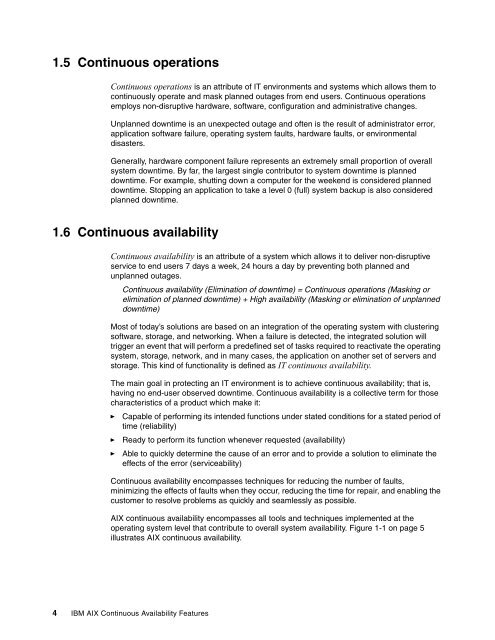IBM AIX Continuous Availability Features - IBM Redbooks
IBM AIX Continuous Availability Features - IBM Redbooks
IBM AIX Continuous Availability Features - IBM Redbooks
Create successful ePaper yourself
Turn your PDF publications into a flip-book with our unique Google optimized e-Paper software.
1.5 <strong>Continuous</strong> operations<br />
<strong>Continuous</strong> operations is an attribute of IT environments and systems which allows them to<br />
continuously operate and mask planned outages from end users. <strong>Continuous</strong> operations<br />
employs non-disruptive hardware, software, configuration and administrative changes.<br />
Unplanned downtime is an unexpected outage and often is the result of administrator error,<br />
application software failure, operating system faults, hardware faults, or environmental<br />
disasters.<br />
Generally, hardware component failure represents an extremely small proportion of overall<br />
system downtime. By far, the largest single contributor to system downtime is planned<br />
downtime. For example, shutting down a computer for the weekend is considered planned<br />
downtime. Stopping an application to take a level 0 (full) system backup is also considered<br />
planned downtime.<br />
1.6 <strong>Continuous</strong> availability<br />
<strong>Continuous</strong> availability is an attribute of a system which allows it to deliver non-disruptive<br />
service to end users 7 days a week, 24 hours a day by preventing both planned and<br />
unplanned outages.<br />
<strong>Continuous</strong> availability (Elimination of downtime) = <strong>Continuous</strong> operations (Masking or<br />
elimination of planned downtime) + High availability (Masking or elimination of unplanned<br />
downtime)<br />
Most of today’s solutions are based on an integration of the operating system with clustering<br />
software, storage, and networking. When a failure is detected, the integrated solution will<br />
trigger an event that will perform a predefined set of tasks required to reactivate the operating<br />
system, storage, network, and in many cases, the application on another set of servers and<br />
storage. This kind of functionality is defined as IT continuous availability.<br />
The main goal in protecting an IT environment is to achieve continuous availability; that is,<br />
having no end-user observed downtime. <strong>Continuous</strong> availability is a collective term for those<br />
characteristics of a product which make it:<br />
► Capable of performing its intended functions under stated conditions for a stated period of<br />
time (reliability)<br />
► Ready to perform its function whenever requested (availability)<br />
► Able to quickly determine the cause of an error and to provide a solution to eliminate the<br />
effects of the error (serviceability)<br />
<strong>Continuous</strong> availability encompasses techniques for reducing the number of faults,<br />
minimizing the effects of faults when they occur, reducing the time for repair, and enabling the<br />
customer to resolve problems as quickly and seamlessly as possible.<br />
<strong>AIX</strong> continuous availability encompasses all tools and techniques implemented at the<br />
operating system level that contribute to overall system availability. Figure 1-1 on page 5<br />
illustrates <strong>AIX</strong> continuous availability.<br />
4 <strong>IBM</strong> <strong>AIX</strong> <strong>Continuous</strong> <strong>Availability</strong> <strong>Features</strong>

















